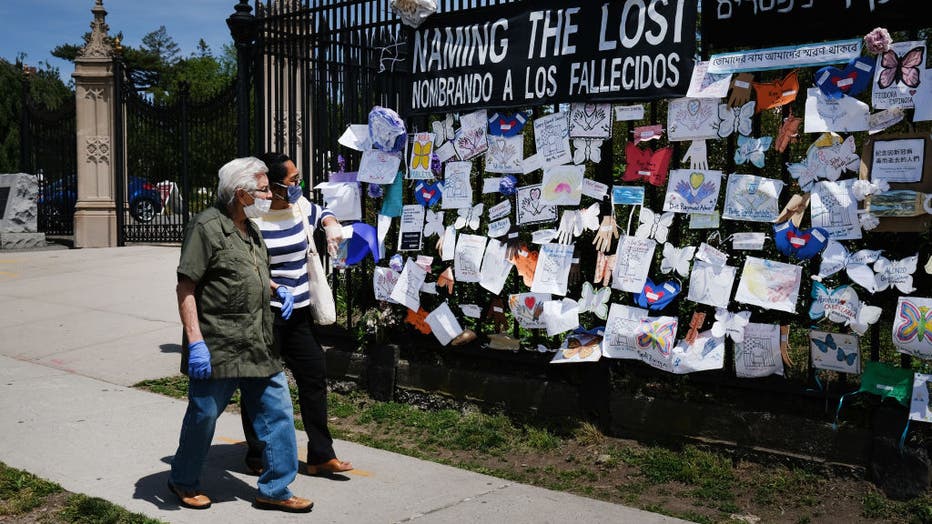US coronavirus deaths top 100,000, according to Johns Hopkins
More than 100,000 individuals in the United States are confirmed to have died after contracting the novel coronavirus, according to the most recent data from the Johns Hopkins’ Coronavirus Resource Center.
As of May 27, there were more than 1.6 million confirmed cases in the United States. Across the world, there were more 5.6 million confirmed cases and 350,000 deaths from COVID-19.
Comparing how the virus has impacted different countries is tricky, given varying levels of testing and the fact that some coronavirus deaths can be missed. According to figures tracked by Johns Hopkins University, the death rate per 100,000 people is lower in the U.S. than Italy, France and Spain but higher than Germany, China, South Korea, Singapore, Japan, New Zealand and Australia.

People walk by a memorial for those who have died from the novel coronavirus outside Green-Wood Cemetery on May 27, 2020 in the Brooklyn borough of New York City. (Photo by Spencer Platt/Getty Images)
“The experience of other countries shows that death at that scale was preventable,” Kaiser Family Foundation's Josh Michaud said. “To some extent the United States suffers from having a slow start and inconsistent approach. We might have seen a different trajectory if different policies were put into place earlier and more forcefully.”
Countries with low death rates suppressed the virus “through lots of testing, contact tracing and policies to support isolation and quarantine of people at risk,” Michaud said.
RELATED: It’s not junk mail: Coronavirus stimulus payment debit cards come in plain envelope
The milestone comes at a time when many parts of the country have reopened their economies against the greater warnings of public health officials like Dr. Anthony Fauci, who has reiterated that a second wave of coronavirus will likely strike this fall. President Donald Trump has urged states to “open up ASAP.”
On Sunday, the front page of the The New York Times contained the names of 1,000 individuals who had died from COVID-19 in the United States with a harrowing preface: “They were not simply names on a list, they were us.”
With no larger orders from the federal government as to when economies can reopen, state and local leaders must navigate the challenging tightrope of reinvigorating their local economies and combating record unemployment levels while keeping their residents safe and preventing the spread of COVID-19.
California, for example, gave the OK for churches to reopen on Monday with certain attendance and participation restrictions. The green light followed pressure from some religious leaders in the state as well as a verbal directive from Trump on May 22 to open churches “right away.”
But the grim milestone also comes days after the Centers for Disease Control and Prevention (CDC) issued a warning that cited two individuals with COVID-19 who infected dozens after attending a church service.
RELATED: CDC warns of COVID-19 spread in group gatherings after 2 people infect dozens at church
The death milestone also comes at a time when widespread testing and treatment options are still unavailable across the country. Trials have indicated that remdesivir can be an effective treatment option for COVID-19, while hydroxychloroquine, a drug that had been frequently touted by the president and one that he indicated he was even taking himself, has been reported to cause adverse health effects in some patients.
The World Health Organization (WHO) temporarily halted hydroxychloroquine trials on Monday out of safety concerns.
While the race for a coronavirus vaccine has captured the attention of everyone from Washington to Wall Street, health officials have previously indicated that we are still 12 to 18 months away from a vaccine being widely available. A recent poll found that only half of Americans would opt to receive a coronavirus vaccine.
RELATED: CoronavirusNOW.com, FOX launches national hub for COVID-19 news and updates
Other public health experts cautioned that even more death is in the future.
“Despite the terrible losses seen and the many difficulties Americans have faced to date in this pandemic, we’re still probably only in the early stages,” said Josh Michaud, associate director of global health policy with the Kaiser Family Foundation in Washington. “In the U.S. we could be looking at a long pandemic summer with a slow burn of cases and deaths. There’s also reason to be concerned about a new wave of infections in the fall. So, we’re definitely not out of the woods yet.”
The Associated Press contributed to this story.


